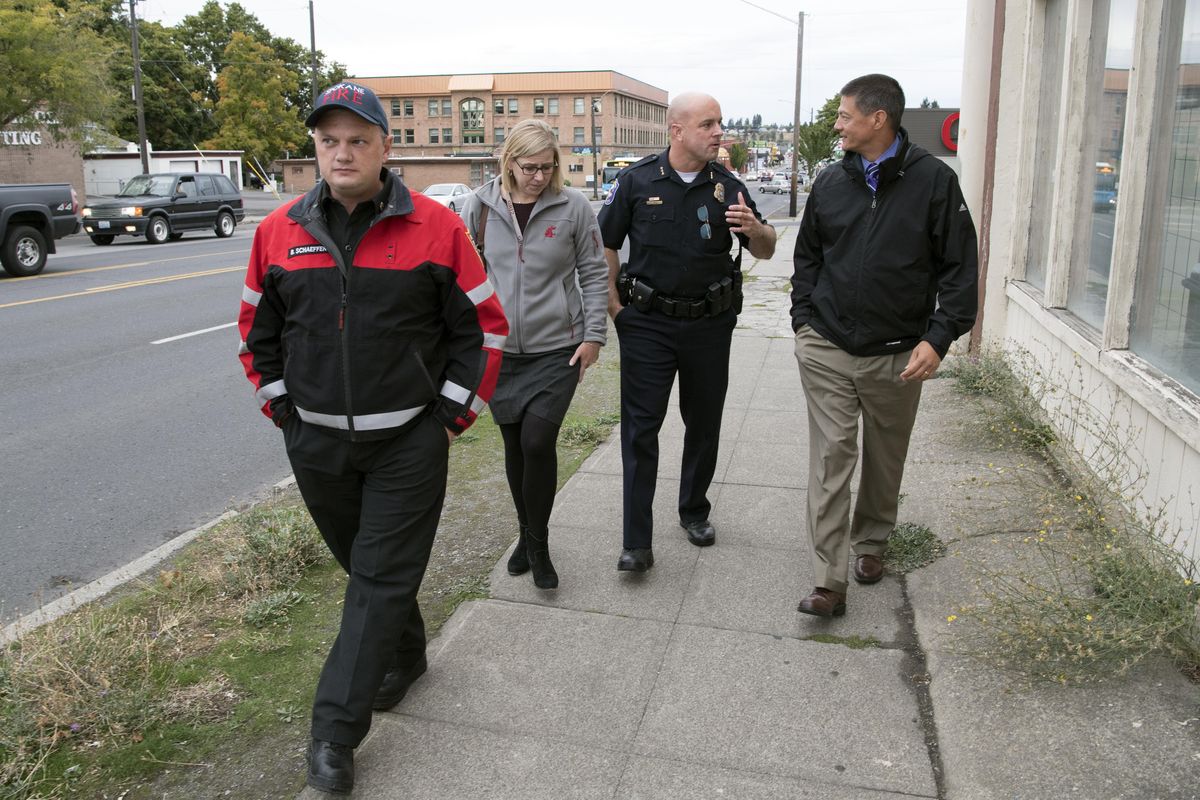Spokane police and fire chiefs push back on sheriff’s criticism of North Monroe project

Spokane’s police and fire chiefs said they are united in their support of a street renovation project on North Monroe Street, and do not share Sheriff Ozzie Knezovich’s concern that its design would hinder a downtown evacuation in case of emergency.
“One hundred percent correct,” said Police Chief Craig Meidl, when asked if Monroe would suffice as an emergency evacuation route after it is reduced to three lanes from five.
Fire Chief Brian Schaeffer agreed.
“It just seems so common sense to me,” Schaeffer said. “I don’t even get the evacuation argument.”
The $7.1 million, eight-month project will reduce the number of lanes, construct more visible crosswalks with pedestrian-activated signals and make the business center’s sidewalks wider with more trees and benches. The three lanes will combine to be a 34-foot-wide roadway, including a turning lane with no medians or pedestrian islands. The current five-lane configuration is 51 feet wide.
Meidl said he didn’t question Knezovich’s judgment, but said he was more concerned with the dangerous conditions facing Monroe’s pedestrians.
“I’m not discounting the sheriff’s concerns, but his concerns are just one aspect of this design. It’s only one of the factors we should consider,” Meidl said, noting that traffic fatalities have occurred in recent memory on Monroe, but an evacuation of downtown has not.
“I can think of two right off the top of my head in the last couple of years,” he said of fatalities.
Since 2010, there have been 16 collisions between pedestrians and motorists on that stretch of Monroe, according to the Washington state Department of Transportation crash data. Most have been minor, but pedestrians were killed in two of those, in 2011 and 2013.
Schaeffer said Monroe’s new design gives “better maneuverability” for his department’s fire trucks.
“I’m looking forward to it,” he said. “The new configuration widens the lanes, providing us a safer route of travel.”
Sheriff says city ignores citizens
Last week, Knezovich waded into the contentious discussion over the roadwork by saying it would “decrease the public safety for the entire region.” Knezovich did so at the request of Spokane City Councilman Mike Fagan, who filed a City Council resolution to stop the project Wednesday.
Fagan’s resolution seeks to stop the reduction in lanes while keeping other elements of the plan, such as beautification and safety improvements. Marlene Feist, director of strategic development for the Public Works and Utilities Department, said the project was unlikely to go forward without the lane reduction because it’s largely funded by a federal highway safety grant that was awarded based on the three-lane design.
Under the city’s six-year plan, road projects with matching grant funding are prioritized. Without the federal grant, a Monroe road project would likely fall down the list and not see construction for years.
In an email to other council members, Fagan said the “passing of this resolution would result in the suspension of the $15 million lawsuit and more.”
A $15 million tort claim was filed last month by the Monroe Street Business Association, which cited the potential for “significant revenue losses” during the city’s planned renovation of the street. That business association was incorporated in June by Gary Jarvis, the owner of Skipper’s on Monroe, to fight the project.
Following news of the sheriff’s letter, Council President Ben Stuckart suggested Knezovich was acting politically, and not out of concern for public safety. Stuckart noted that one of Knezovich’s campaign contributors, Harlan Douglass, owned multiple properties on the street.
In an interview late last week, Knezovich called Stuckart’s comments “unsavory” and “slimy politics” and asked for Stuckart to apologize to him. He said his “office is not for sale.”
“I couldn’t tell you where Mr. Harlan owns property. I have not talked to Mr. Harlan about this project,” Knezovich said. “I didn’t just insert myself into this. Ben’s citizens came to me because they are not being listened to.”
But while Knezovich pushed back against Stuckart’s comments, he also mentioned other concerns. He said the road originally was widened for pollution mitigation, but a review of Spokesman-Review articles from the mid-1970s, when the road was pushed to five lanes, reflect only an urge by traffic engineers to let more traffic flow.
Knezovich also said he had only heard from one person who supported the project in an email. He criticized elected officials at the city for ignoring their constituents, of which he is one.
“Their elected leaders are no longer listening to them,” he said. “Cold fact of it: They got a grant and they want to spend the grant. That’s not a good reason to do the project when your citizens are saying no. As a citizen of the city now, I find it very interesting that just because you got a grant doesn’t mean you have to spend it.”
Stuckart rejected that.
“We’re doing this project because it was in the (Emerson-Garfield) neighborhood plan and there was enormous public outreach until the very end,” Stuckart said.
The “vast majority” of residents in the area support the project, Stuckart said, and the people talking to Knezovich are business owners who didn’t take part in the process.
“That’s why they’re angry. Because they didn’t participate,” Stuckart said. “Citizens of the city came up with the plan. The citizens that live there overwhelmingly support the plan. He is hearing from a minority of business owners.”
Knezovich said he hasn’t spoken to Mayor David Condon about the project, but he counted him among city leaders ignoring concerns of voters.
“I really don’t understand what the big push is,” he said. “It’s a bunch of people bowing up their necks.”